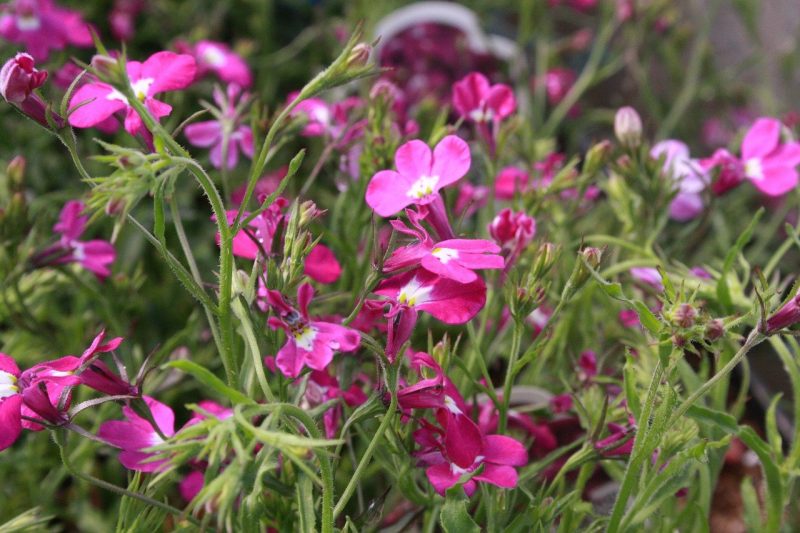In general, you can know how to keep lobelia blooming all summer using one maintenance practice, which is pruning. Much like anthuriums, simple maintenance practices and using a stable environment like the greenhouse can keep your plants blooming, encourage them, or even extend the bloom itself. However, you must check the many different lobelia species to determine the specific needs of your plants.
More so, remember that lobelia plants are poisonous when ingested. If you’re pruning them, be mindful of nearby pets and children. Otherwise, this practice should encourage an extended blooming period while also preventing the plants from overgrowing.

How To Keep Lobelia Blooming All Summer: Beginner’s Guide
Pruning lobelia
As mentioned earlier, there is only one practice to consider if you want to keep your lobelia plants blooming all summer. Pruning lobelia does not only improves the appearance of your plants and benefits their health. This practice will also encourage blooming and lengthen the duration of this period.
Many practices encompass the term pruning in lobelias. They include pinching, trimming, and cutting back. These methods differ on the ideal time to do so, and you’ll also do them with a specific outcome in mind. To extend the blooming period of lobelia in summer or encourage a second bloom, you can trim your plants at any time of the year.
This encourages another flush of blooms, maintains their overall look, and some gardeners even prune the plant at half an inch when the blooming period ends. Depending on the lobelia plant you have, you can deadhead it to help the plant produce more flowers. Do note that some lobelias are self-cleaning anyway and won’t require you to remove the faded blossoms.
Caring For Lobelia To Help With Blooming
While the straightforward answer on how to keep lobelia blooming all summer is by pruning the plants, the plant’s overall care will surely extend the flowering period. Remember that regardless of the plant you have, maintaining and caring for it is significantly influential to its blooms. For example, you can grow your plants in the greenhouse if your region experiences fluctuating climates.
Ideal environment
Remember that the ideal location of lobelias will vary depending on if they are annual or perennial. Annual lobelias thrive best in zones 1 to 10, while perennial lobelias can grow in zones 2 to 10. Some lobelias are also considered half-hardy annuals and perennials where some like full sun or partial shade.
In general, the ideal temperature for lobelias is around 70°F. You can tailor the environment for your plants using a greenhouse to help promote flowering. More so, don’t forget that maintenance practices will also affect the health and blooming of lobelias.
Watering and fertilizing
For example, during the summer, the dry and hot conditions will require you to water your lobelias more often. Always check their medium, especially those in containers, because they can get dry quickly. Annual lobelias will also require feeding to ensure that they will bloom throughout the season.
Gardeners recommend a 12-4-8 liquid fertilizer every two to three weeks throughout the season. This will help your plants have enough energy to produce blooms without problems. Some even feed every four weeks or once a month with a general-purpose fertilizer as part of maintenance.
Problems to look out for
Undoubtedly, preparing for common problems and doing prevention practices will ensure that they will bloom throughout the season without drawbacks. One of the most common issues that can halt lobelias to flower in the summer is when they experience drought. To anticipate this, water them deeply and mulch to conserve soil moisture.
You also want to check the plants regularly for pests like spider mites, especially in the summer’s humidity. A useful technique to prevent mite infestation is misting with cold water with Neem oil. And if you noticed signs of infestation, isolate the infected plants immediately.
Planting Lobelias
Knowing when to plant lobelia plants will also ensure that they’ll bloom on time in summer. You can grow bedding lobelias after frost at the end of May or early in June in the greenhouse. Once they have established themselves, you can transplant in early summer.
On the other hand, you can plant perennial lobelias in early spring or autumn as long as the ground is not frozen. You can plant them at any time of the year as well, especially those with a greenhouse.
Conclusion
Spring is not the only season to have a colorful garden. Knowing how to keep lobelia blooming all summer will land you a lively garden even when other plants have stopped blooming. The primary practice to extend the blooming period of lobelias is by pruning.
Some plants also benefit from deadheading to help encourage them to produce more blooms. More so, maintenance and care for lobelias will guarantee flowering throughout the summer season. For example, use a greenhouse to maintain the ideal location for lobelias.
Keeping the plants hydrated and well-fed will also encourage flowering and blooming in the summer. Water the plants deeply and feed them with a liquid fertilizer every two weeks. More so, mist with cold water and Neem oil to prevent summer pests like spider mites.

I have a plant that is about 18 months old in a pot on the balcony. I did not prune it because the foliage is nice and hanging down. But I have had ZERO flowers since last Summer. Not a single head even forming now. Would you say that if I trim it back hard now (start of spring) I might get some flowers? Thanks so much.
Hi Chris. Your comment really caught my eye since I have the exact problem – no blooms. Did you ever get yours figured out? Mine is an Aguana, do you know which species you have? Best of luck, and I hope to hear from you.
Shari